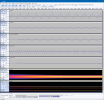I blow an 'A' in a pitch pipe and record it to a WAV file. I then calculate how many data points I'd need to see a full cycle 48000 / 453 (not true 'A', what AUBIO shows) = ~ 106

The waves look very consistent over time. I get this "wave" wherever I chart a sample of 106 points.
I then generate an A-note using SOX
And I get this, which is what I expect

I've tried all kinds of variations of these files, changing sampling rates, channels, etc. But same problem. How does Aubio know it's 453hz, but the wave looks like it's 880hz? Or does that data resolve, perceptually, to 440?
I must be missing something simple but I can't figure it out! THANKS for anyone's help! I attached the WAV files and their data.
The waves look very consistent over time. I get this "wave" wherever I chart a sample of 106 points.
I then generate an A-note using SOX
sox -V -r 20050 -n -b 16 -c 1 sin440hz.wav synth 30 sin 440 vol -10dBAnd I get this, which is what I expect
I've tried all kinds of variations of these files, changing sampling rates, channels, etc. But same problem. How does Aubio know it's 453hz, but the wave looks like it's 880hz? Or does that data resolve, perceptually, to 440?
I must be missing something simple but I can't figure it out! THANKS for anyone's help! I attached the WAV files and their data.


